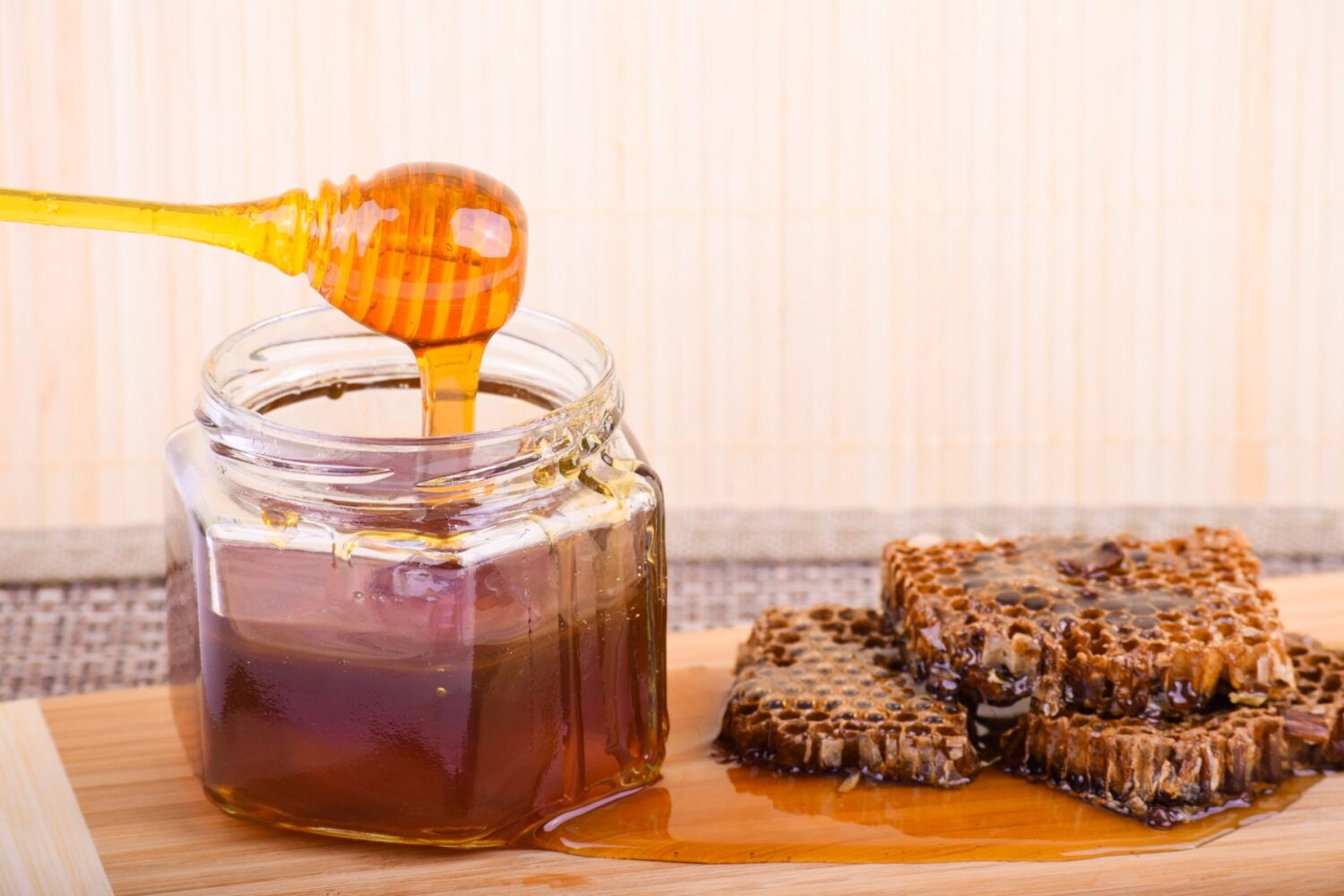How to Store Honey – The Survival Mom


[ad_1]
Honey is known as a “forever food.” It can be stored indefinitely so its sweetness and health benefits can be used many years down the road. If you’re looking for tips for how to best store honey so it remains fresh, here’s what you need to do — tips directly from an experienced beekeeper.


Some of the links in this post may contain affiliate links for your convenience. As an Amazon Associate, I may earn a small commission from qualifying purchases without any increase in price to you.
Ahh, honey. Sweet, sweet honey. It is such a versatile food staple to have on hand. Not only is it a sweetener, but it’s also great for medicinal purposes; such as calming a sore throat or as a cough suppressant. It’s a natural energy booster and wonderful for the skin, too.
Note: Never give honey to a child 12 months old or younger because of the risk of infant botulism.
Honey, The Forever Food
Honey can be stored indefinitely, and I can prove it! In 1922, archaeologists discovered pots of honey in King Tutankhamun’s tomb that were over 3,000 years old. It was still perfectly edible! And in 2003, the world’s oldest honey was found during construction of an oil pipeline near Tbilisi, Georgia. Estimated to be over 5,500 years old, it had been stored in ceramic vessels that were part of a burial site.
That’s pretty incredible, but what is it about honey that makes it so special when it comes to being a forever food?
The Science Behind Honey Storage
Honey is composed almost entirely of sugars — mostly fructose and glucose. This makes honey hygroscopic, which means that it can absorb moisture from the air. The honey you purchase will have a moisture content of 17-18%. If it contains more, it’s likely to ferment if left on the shelf long enough.
When we harvest our honey, we use a honey refractometer to make sure it isn’t too moist for bottling. Some years, the honey has a higher moisture content, and in those cases, we store it near a dehumidifier for a few days until the moisture level is 18% or lower. This ensures it stays fresh, doesn’t ferment, and doesn’t become a breeding ground for bacteria and other microorganisms.
Along with the proper moisture level, honey is slightly acidic with a pH level of around 3.9. This is another characteristic of helps prevent the growth of bacteria. Even better, natural honey contains enzymes and various antimicrobial compounds such as hydrogen peroxide that contribute to its indefinite shelf life.
All this together guarantees that honey will last just about forever.
Choosing the Right Container
As beekeepers and sellers of raw honey, we’ve noticed that more and more of our customers are requesting glass containers. When you read news reports of microplastics being discovered in just about every part of the human body, choosing to limit that exposure makes sense.
So, we now use only glass containers. It’s non-reactive, which means it won’t react with honey in any way. It’s also easy to clean and it’s dishwasher safe. And, as a seller of honey, I like being able to see the different colors of our honey and the amount of any crystallization.
On the downside, glass is going to be heavier, and it’s breakable, but overall, it’s my number one choice and recommendation.
If your honey is stored in plastic containers, if you’ll be using it up in a short amount of time, no worries. Plastic is lightweight, and food-safe plastics are probably not going to affect the flavor of your honey. But if you’re planning to store the honey long-term, I recommend pouring in large glass jars and then keep them tightly capped.
Whatever container you use, keep in mind that it needs to have a tightly fitting cap. Remember that honey is hygroscopic and will begin absorbing moisture in the air, and that’s not a good thing.
Considerations for Different Types of Honey
Raw honey is what we harvest direct from the hive. In this image, you can see one of our frames loaded with honey ready for harvesting.
Raw
Raw honey is a little more sensitive to moisture and temperature, which makes sense. It’s at this point the honey is in its most natural state with the highest levels of enzymes, minerals, vitamins, amino acids, and dozens of other components. If you’re lucky enough to get raw honey, store it in glass jars and keep them tightly capped.
Pasteurized
Pasteurized honey is a little different. This honey has been heated to a high temperature to kill off any possible, unwanted bacteria, yeast, or other microorganisms. It has also been filtered, removing pollen and other natural components. This honey is a lot less likely to crystallize, which is one of the hallmarks of raw honey. Glass containers for storage are my recommendation for the reasons mentioned above, but for short-term storage and use, plastic is fine.
Finally, if you have raw honey, over time it will crystallize.
No worries because this is just an indicator that your honey is, indeed, raw and unfiltered. However, keep it stored at room temperature instead of in the fridge. Cold temperatures will only speed up the crystallization making it a little less convenient to use.
Optimal Storage Conditions
I like to think of honey as an almost living substance. It’s a complex, miraculous creation that is not only benefits our taste buds but has amazing medicinal qualities as well. For these reasons, it should be stored at room temperature (cooler is better), kept away from heat sources like furnace vents.
You want those active enzymes and minerals, and heat can and will destroy them.
As much as you and I love honey, pests like ants, racoons, and bees (yes, bees!) love it, too! Make sure your honey containers are wiped clean of any drips, they’re stored in a location safe from insects and rodents, and then, again are in tightly capped containers.
How Do You Store Honey Long-Term?
Honey enzymes will slow down or become dormant in cold temperatures, but they’ll fully reactivate when the honey warms up to room temperature.
I haven’t found any advantage to storing honey in the refrigerator or freezer. Personally, I like honey at room temperature, but this falls into the category of personal choice.
Room Temperature
Storing honey at room temperature is the best way to ensure it remains in its liquid form. It’s always ready and easy to pour, measure out, and use. However, storing it in a refrigerator or freezer is also possible, although this will have a few disadvantages.
Refrigerator
In the refrigerator, crystallization can actually speed up. Honey naturally crystallizes over time because of its high sugar content. The cool temperatures in a refrigerator promote the formation of glucose crystals, causing the honey to solidify more quickly than it would at room temperature.
Freezer
The opposite can happen when honey is frozen. The low temperatures prevent the glucose molecules from forming crystals, keeping the honey in its liquid state. However, once thawed, the honey may crystallize more quickly if it was already starting to crystallize before being frozen.
3 Ways to De-Crystalize Honey
Over time, raw honey will begin forming crystals. If you wonder whether or not the honey you bought is raw and unfiltered, this is a dead giveaway! De-crystalizing honey is a simple process. You only need to be careful with the level of heat applied since you want your honey to retain all of its natural nutrients and other components.
Hot water bath method
This is the slowest method but also the one I prefer and recommend.
Fill a pot or large bowl with enough very hot water to cover most of the honey jar. If the water is at a boiling temperature, it’s too hot. You want it to be no hotter than 100° F (38° C). Let the honey sit in the hot water for 15-20 minutes or so until the crystals begin to dissolve.
If the honey is heavily crystallized, you may have to do this a second time. Stir to help the crystals dissolve.
Microwave method
If you’ve ever burned your tongue with hot syrup or honey, you know just how hot these thick, viscous liquids can get! A microwave is a lot faster than using a hot water bath, but you’ll need to be careful to not overheat the honey and not touch the honey if it gets too hot.
Take the lid off your honey container, set the microwave at medium, and microwave for ten seconds at a time. stir until it’s once again clear and free of crystals.
Oven method
The oven method is best for larger amounts of honey as you can heat up several jars at the same time.
Preheat your oven to its lowest setting, around 100°F/38°C. Remember that 104°F is the threshold when honey enzymes begin to deteriorate. If you don’t have an accurate food thermometer, this would be a good reason to buy one!
In a 9×13 pan or similar, add a half inch or so of water and then your jars of honey with lids removed. Let the honey sit in the warm oven until the crystals are dissolved. Stir and repeat the heating process if necessary.
Frequently Asked Questions
It will have a sour or fermented smell to it, and there might even be mold growing inside the jar or on the surface of the honey. If this happens, then it’s most likely caused by some sort of cross-contamination. Throw out the honey.
It can change color but not always. Naturally dark honey can become even darker over time, and when honey crystallizes, that can change its color, too. Storage conditions can also affect the color of honey, so try to always store it in a dark, dry, and cool location.
Over time, raw honey will begin forming crystals. If you wonder whether or not the honey you bought is raw and unfiltered, this is a dead giveaway!
Related Honey Content
Get your FREE guide to creating a balanced pantry!
Are you prepared for a food shortage? Building a balanced pantry is essential for emergency preparedness. We’ve created a FREE guide to help you get started. Don’t be caught unprepared. Download your FREE Tips to a Balanced Pantry now!
Final Thoughts
Honey is a remarkable natural sweetener that can last indefinitely. By understanding the best storage practices – from temperature control to container choice – you’re not only preserving its flavor but also safeguarding its natural enzymes and antioxidants. So, whether you’re a casual honey lover or a seasoned enthusiast, implementing these tips will ensure your honey remains a delightful treat for years to come.
[ad_2]
Source link
Recent Posts
Dear Diary, It’s Me, Jessica: Part 16
[ad_1] If you're new here, you may want to subscribe to my RSS feed. Thanks…
Google Faces Lawsuit After $5M in Crypto Stolen via Play Store App
[ad_1] A Florida woman, Maria Vaca, has sued Google in a California state court, alleging…
All About Water Purification: A Complete Tutorial
[ad_1] You may need to purify water to make it safe to drink. The process…
Protocol Village: Quai Releases Mainnet-Compatible Devnet, Crunch Lab Raises $3.5M
[ad_1] The latest in blockchain tech upgrades, funding announcements and deals. For the period of…
The Grim New Daily Life in Venezuela
[ad_1] If you're new here, you may want to subscribe to my RSS feed. Thanks…
World’s 3rd largest public pension fund buys $34M MicroStrategy shares
[ad_1] The third-largest public pension fund in the world has just bought nearly $34 million…
